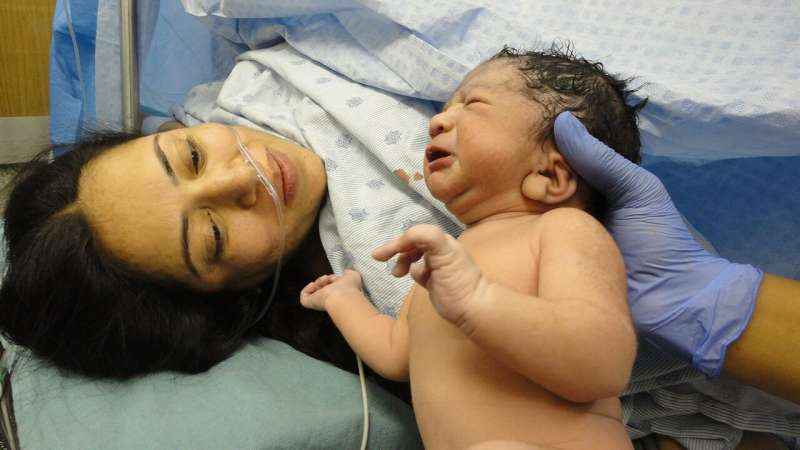Study shows potential for 'cracking' technology to reduce environmental impact of nitrous oxide used during labor

A study published in Anaesthesia shows the potential for using "cracking" technology to reduce the environmental impact of nitrous oxide (N2O), used extensively to manage pain during labor.
The study was conducted by a multidisciplinary team of anesthetists and midwives from St John's Hospital, Livingston, UK and Manchester University NHS Foundation Trust, Manchester, UK. The lead author of the study is Dr. Annie Pinder, Fellow in Sustainable Healthcare at the North West School of Anaesthesia, Manchester, UK. The study was supervised by Consultant Anaesthetist Dr. Cliff Shelton, of Wythenshawe Hospital and Lancaster University, UK.
All inhaled anesthetic gases in common use today are greenhouse gases. Compared to an equivalent mass of carbon dioxide (CO2), nitrous oxide has 265 times the global warming potential. Nitrous oxide, the painkilling component of "gas and air," is the most frequently used labor painkiller in the UK, and is available in all birth settings. Thus, any intervention that reduces nitrous oxide release into the atmosphere has the potential to significantly reduce the environmental impact of this medication.
One method which may reduce the carbon footprint of nitrous oxide is to break down ("crack") the exhaled gas into nitrogen and oxygen using a catalyst. Previous research has established the efficiency of this process—however, to be effective in practice, as much exhaled nitrous oxide as possible must be "scavenged" (captured) so that it can be broken down. This relies on patients being able to consistently breathe out into a mask or mouthpiece.
In this quality improvement project, based on environmental monitoring and staff feedback, the authors assessed the impact of nitrous oxide cracking technology in the maternity setting. Nitrous oxide levels were recorded during the final 30 minutes of uncomplicated labor in 36 cases. In the first 12 cases, readings were taken without the use of the technology to establish a baseline. Subsequently, the study team introduced the cracking device, and took a stepwise approach to optimizing its clinical use. This involved using a mouthpiece, then two different types of facemask, and providing patients with tips for use and feedback.
The results showed that median ambient nitrous oxide levels were 71% lower than baseline when using a mouthpiece, and 81% lower when using a low-profile facemask (a lightweight facemask with a flexible seal) together with coaching on how best to use it.
The authors say, "Given that a similar magnitude of reduction in nitrous oxide levels was seen with mouthpieces and low-profile facemasks, we suggest that pregnant women should be offered the option of either device when cracking is used. Education for pregnant women and choice in use of device is vital given the high degree of cooperation required [for the successful use of the technology], and this is consistent with guidelines for choice and personalized care in maternity services. Future research to better characterize the optimal use of this technology could focus on investigating other delivery device types, and considering the optimal timing and method of education—for example, is the antenatal clinic a better place to discuss this technology than during the birth period?"
The authors note that they attempted to avoid burdening pregnant women with "climate guilt" during their labor; for example by making it clear that greenhouse gas emissions associated with nitrous oxide are the responsibility of the health care organization—rather than of the patients.
They add, "Staff feedback was generally positive, though some found the technology to be cumbersome; successful implementation relies on effective staff engagement. Our results indicate that cracking technology can reduce ambient nitrous oxide levels in the obstetric setting, with potential for reductions in environmental impacts and occupational exposure."
More information: Implementing nitrous oxide cracking technology in the labour ward to reduce occupational exposure and environmental emissions: a quality improvement study*, Anaesthesia (2022). doi.org/10.1111/anae.15838



















